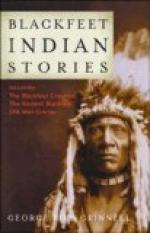As soon as the buffalo had come well within the diverging lines of people who were hidden behind the piles of stones called wings, those whom the buffalo passed rose up from their places of concealment, and by yells and shouts and the waving of their robes frightened the buffalo, so that they quite forgot their curiosity in the terror that now replaced it. When the leaders reached the brink of the cliff, they could not stop. They were pushed over by those behind, and most of the buffalo jumped over the cliff. Many were crippled or injured by the fall, and all were kept within the fence of the piskun below. About this fence the people were collected. The buffalo raced round and round within the pen, the young and weak being injured or killed in the crowding, while above the fence men were shooting them with arrows until presently all in the pen were dead, or so hurt that the women could go into the pen and kill them. The people entered and took the flesh and hides.
Deer, elk, and antelope were shot with arrows, and antelope were often captured in pitfalls roofed with slender poles and covered with grass and earth. Such pitfalls were dug in a region where antelope were plenty, and a long > shaped pair of wings, made of poles or bushes or even rock piles, led to the pit. The antelope is very inquisitive and was easily led within the chute and there frightened, as were the buffalo, by people who had been concealed and who rose up and showed themselves after the antelope had passed. This was done more in order to secure antelope skins for clothing than their flesh for food.
Fish and reptiles were not eaten by the Blackfeet, nor were dogs, although dogs, wolves, and coyotes are eaten by many tribes of plains Indians. Most small animals, and practically all birds, were eaten in case of need. In summer, when the wildfowl which bred on so many of the lakes in the Blackfeet country lost their flight-feathers, during the moult, and again in the late summer, when the young ducks and geese were almost fullgrown but could not yet fly, the Indians often went in large parties to the shallow lakes which here and there dotted the prairie, and, driving the birds to shore, killed them in large numbers.
Earlier in the season, when the fowl had begun to lay their eggs, these were collected in great quantities for food. Sometimes they were roasted in the hot ashes, but a more common way was to dig a deep, narrow hole in the ground in which the eggs were to be cooked. Several little platforms of small sticks or twigs were built in this hole, one above another, and on these platforms they put the eggs. Another much smaller hole was dug to one side of the large hole, slanting down into it. The large hole was partly filled with water, and was then roofed over by small sticks on which was placed grass covered with earth. Stones were heated in a fire built near at hand, and then were rolled down the side hole into the larger hole, heating the water, which at last boiled and steamed, the steam cooking the eggs.




